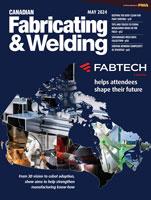Editor
- FMA
- The Fabricator
- FABTECH
- Canadian Metalworking
New chair adds to Canada’s welding research strength
BCIT partners with Seaspan to expand study of welding tech, metallurgy
- By Rob Colman
- December 24, 2021
A number of Canadian colleges and universities have strong industry partnerships that support the study of welding technologies and metallurgy. These partnerships have helped both the universities and their partners to expand their knowledge base and business value.
This tradition continues with the announcement of the establishment of a new research chair at the British Columbia Institute of Technology (BCIT) by BCIT and Seaspan Shipyards (Seaspan). The Centre of Welding Technologies and Metallurgy Research Chair, the first at BCIT to be exclusively based on funding and collaboration with an industry partner, aims to enhance B.C.-based industrial research capabilities in advanced welding and metallurgy – two of the most foundational and critical areas of marine manufacturing.
Seaspan will invest $1.65 million over five years to fund the new chair and a supporting centre of expertise managed by an industry professional, with instructors, analysts, and associated research equipment and materials.
In collaboration with Seaspan, the research chair will focus on advancing the state of practice in welding engineering. Welding technologies and metallurgy are evolving rapidly to address the needs of new ship designs and materials, as well as the increasingly complex structural and operational requirements of modern vessels, including those used for icebreaking in harsh ocean conditions.
The chair will identify and conduct applied research into emerging areas that are expected to provide Seaspan and the broader marine sector in B.C. with manufacturing advantages and competitive differentiation. The new technologies and techniques developed through the work of the chair are also expected to lay the foundation for innovations in BCIT’s training and certification programs, addressing the growing need to continuously develop and train skilled local talent.
The new Seaspan-BCIT collaboration intends to provide immediate benefits for the ships Seaspan designs and builds under the National Shipbuilding Strategy. For example, the new Polar Icebreaker and fleet of multi-purpose vessels will provide the Coast Guard with advanced icebreaking capabilities for Arctic and near-Arctic missions. The thicker steel needed for such applications demands advanced and specialized welding methods, and the program is expected to help develop advanced technologies, techniques, and training to meet these requirements.
The establishment of this chair is a great opportunity for Canada to build yet more research strength and produce graduates who will become leaders in their field.
Speaking of leaders, our Next-Generation Manufacturing Leaders article features four individuals who are encouraging industry engagement each in their own way. Each individual takes a different path in their manufacturing careers; these four young leaders reflect those differences and the various ways that the next generation can be encouraged to pursue careers in the field. Check it out here.
subscribe now


Keep up to date with the latest news, events, and technology for all things metal from our pair of monthly magazines written specifically for Canadian manufacturers!
Start Your Free SubscriptionAbout the Author

Rob Colman
1154 Warden Avenue
Toronto, M1R 0A1 Canada
905-235-0471
Robert Colman has worked as a writer and editor for more than 25 years, covering the needs of a variety of trades. He has been dedicated to the metalworking industry for the past 13 years, serving as editor for Metalworking Production & Purchasing (MP&P) and, since January 2016, the editor of Canadian Fabricating & Welding. He graduated with a B.A. degree from McGill University and a Master’s degree from UBC.
- Industry Events
Automate 2024
- May 6 - 9, 2024
- Chicago, IL
ANCA Open House
- May 7 - 8, 2024
- Wixom, MI
17th annual Joint Open House
- May 8 - 9, 2024
- Oakville and Mississauga, ON Canada
MME Saskatoon
- May 28, 2024
- Saskatoon, SK Canada
CME's Health & Safety Symposium for Manufacturers
- May 29, 2024
- Mississauga, ON Canada





















